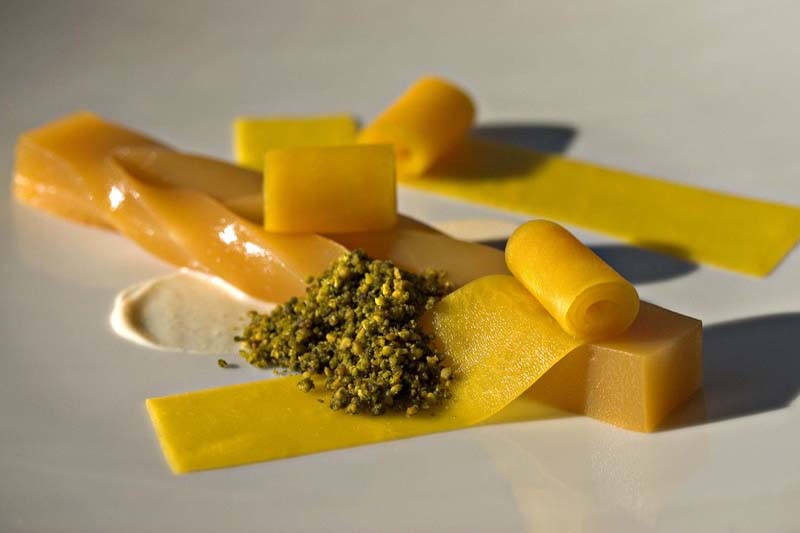Gellan gum is a high molecular weight, extracellular polysaccharide produced by the Fermentation of the bacterium Sphingomonas elodea. Discovered in the late 1960s, it has gained popularity in the food industry as a gelling agent and stabilizer due to its unique properties. In this article, we will explore what gellan gum is, its characteristics, uses, production process and outlook for the future.
Chemical Structure and Properties
Gellan gum is a linear anionic polysaccharide composed of the repeating tetrasaccharide unit L-rhamnose, D-glucose, and D-glucuronic acid. It has a high molecular weight ranging from 50,000 to 800,000 Da. Some key properties that make it attractive for various applications include:
– Ability to form thermoreversible gels that are elastic and flexible in texture. Gel strength is dependent on temperature, ion type and concentration.
– Gels do not dissolve in cold water but become soluble when heated, allowing for easy adjustment of textures.
– Gellan gum solutions exhibit high viscosity even at low concentrations of 0.1-0.5%. This property makes it an effective thickening and stabilizing agent.
– Films formed from gellan gum solutions are clear, colorless, tasteless and odorless. They have good oxygen and aroma barrier properties.
– Gellan Gum is non-toxic and approved as a food additive by regulatory bodies worldwide including FDA and EFSA.
Production Process
The production of gellan gum involves the fermentation of Sphingomonas elodea bacteria followed by downstream processing to extract and purify the polysaccharide. In brief, the steps are:
– Culturing of S. elodea in specialized nutrient media under controlled conditions allows bacteria to secrete gellan gum extracellularly.
– Cells and gellan gum are separated from the fermentation broth through centrifugation or microfiltration.
– Crude gellan gum is purified by precipitation in alcohol solutions, washing, drying and milling.
– The purified gum is heat treated to ensure product consistency and safety before packaging.
Typically, the production cycle takes 5-7 days and yields purity levels above 90%. Continuous advances aim to improve yield, reduce costs and integrate sustainable practices.
Applications in Food Industry
Gellan gum finds wide use as a food additive due to its unique functionalities:
– Used in bakery fillings, doughs, icings to improve texture and prevent syneresis. Examples include pie fillings and fruit gels.
– Provides desirable melting quality in dairy products like cheese sauces and low-fat spreads without affecting taste.
– Acts as a thickening, stabilizing and suspending agent in soups, sauces, gravies, dressings and syrups.
– Forms thermoreversible gels for making jams, jellies, fruit preserves with melt-in-mouth texture.
– Helps maintain shape in molded foods like salad kits, puddings and mousses.
– Finds application as a substitute for gelatin in vegetarian/vegan foods and pharmaceutical products.
Gellan gum in food sector was estimated at $285 million in 2020 majorly driven by Asia Pacific region. The future looks promising with newer innovations.
Other Applications
Apart from food uses, gellan gum has potential in other areas due to its unique material properties:
– Acts as a thickener and suspension aid in industrial products like paints, cosmetics, personal care items and plant fertilizers.
– Used as a stabilizer and film former in the manufacture of tablets and other oral pharmaceutical formulations.
– Finds increasing application in biomedical field as matrices for sustained drug delivery, implants, tissue engineering scaffolds etc.
– Can be used to make biodegradable packaging products, membranes for water treatment and oil-water separation technologies.
– Shows potential as an additive to improve oil recovery operations in petroleum industry.
With continued research focus on value-added applications, gellan gum is forecast to exceed $500 million globally by 2027 according to industry experts. New product varieties are also in the pipeline.
Future Prospects
Given the clean label trends, focus on product differentiation and innovation in diverse industries, the future prospects of gellan gum look bright. Some factors that will further drive growth include:
– Regulatory approvals for new food categories will expand usage scope in prepared foods and beverages sector.
– Functional advances to tailor gelling, thickening properties for specific product characteristics.
– Improvement in largescale production efficiency through continuous bioreactor and recovery technologies.
– Strong pipeline of biomedical, pharmaceutical and industrial applications in areas like tissue engineering and oil recovery.
– Development of gellan gum-based biodegradable packaging materials present huge commercial opportunities.
– Potential as an alternate thickener resource and the ability to address supply chain issues of other gums bode well.
– Greater awareness and marketing campaigns by manufacturers regarding benefits over other agents.
With its versatile functionalities, wide approval status and eco-friendly production method, gellan gum looks set to capture a sizable share of the global hydrocolloid in the coming decade. Continuous research and development remains pivotal to realize its full potential.
*Note:
1. Source: Coherent Market Insights, Public sources, Desk research
2. We have leveraged AI tools to mine information and compile it

